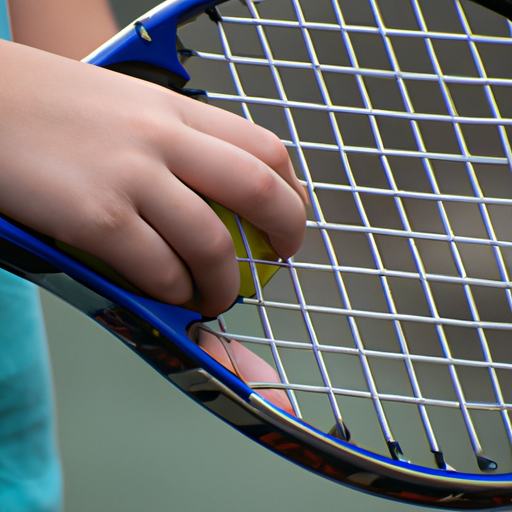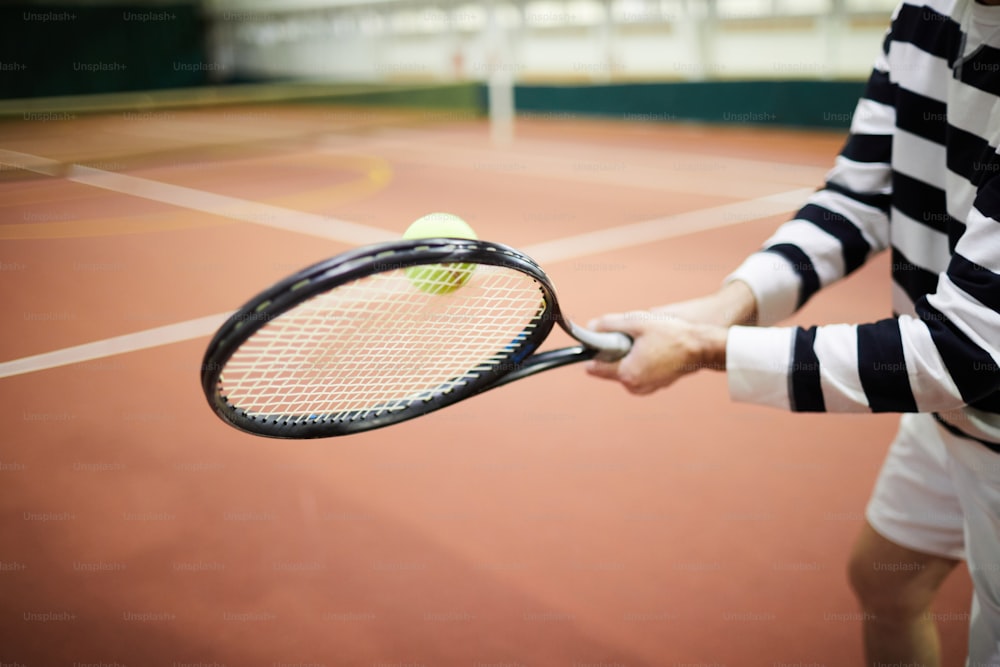So you’ve noticed your child’s growing interest in tennis, and now you’re wondering how to teach them the proper way to hold a tennis racket. Well, fret not! In this article, we will guide you through the steps to help your child master the correct technique for holding a tennis racket, ensuring they develop the solid foundation they need to excel in the sport. With our simple and friendly instructions, you’ll have your little tennis prodigy holding that racket like a pro in no time!
Step 1: Choosing the Right Tennis Racket
Choosing the right tennis racket is crucial in ensuring that your child has a positive experience with the sport. There are a few factors to consider when selecting a racket for your child.
Consider the size and weight of the racket
When it comes to selecting the right racket for your child, size and weight are essential. You want to ensure that the racket is proportionate to your child’s age and physical strength. If the racket is too heavy, it can make it difficult for your child to swing and control the ball. On the other hand, if the racket is too light, it may lack power and stability.
Check the grip size
Another crucial aspect to consider when choosing a tennis racket is the grip size. The grip should be comfortable and secure in your child’s hand. Too large of a grip can result in excess strain on the hand and arm, while a grip that is too small may cause difficulty in holding the racket firmly.
Ensure the racket is appropriate for your child’s skill level
Lastly, it is important to select a racket that matches your child’s skill level. For beginners, a lightweight racket with a larger head size is recommended as it provides a larger sweet spot and is easier to maneuver. As your child progresses and develops better control, you can consider transitioning to a racket with a smaller head and more weight to enhance power and precision.
Step 2: Explaining the Basic Grip
Now that you have chosen the right tennis racket for your child, it’s time to teach them how to hold it correctly. The basic grip in tennis is known as the Eastern grip, which is a versatile grip suitable for various strokes.
Introduce the Eastern grip
The Eastern grip refers to holding the racket with the base knuckle of the index finger resting on the third bevel of the racket handle. The other fingers wrap around the grip naturally. This grip allows for both forehand and backhand strokes, making it a fundamental grip to learn.
Demonstrate the correct hand placement
To teach your child the Eastern grip, demonstrate the correct hand placement. Show them how to position their hand so that the base knuckle of the index finger is aligned with the third bevel of the racket handle. Encourage them to adjust their fingers until they are comfortable and have a firm grasp on the racket.
Teach your child to hold the racket with both hands initially
In the beginning, it can be helpful for your child to hold the racket with both hands. This allows them to get a feel for the grip and develop muscle memory. Once they are comfortable with the grip, they can transition to using just one hand for better control and flexibility.
Explain the importance of a relaxed grip
It is essential to emphasize to your child the importance of maintaining a relaxed grip on the racket. Holding the racket too tightly can hinder their ability to generate power and control the ball. Encourage your child to hold the racket firmly but not so tight that their hand and arm tense up. A relaxed grip promotes fluidity and allows for better shot execution.
Step 3: Practicing the Eastern Grip
Once your child understands the basic grip, it’s time to practice it both on and off the court. Consistent practice will help your child develop comfort and familiarity with the grip.
Encourage your child to practice the grip off the court
To reinforce the Eastern grip, encourage your child to practice it off the court. They can practice gripping the racket correctly at home, in the backyard, or even during other activities. This will help them build muscle memory and develop a natural feel for the grip.
Demonstrate the grip while stationary
Before progressing to on-court drills, have your child practice the Eastern grip while stationary. This allows them to focus solely on hand placement without the added complexity of movement. Have them hold the racket with the correct grip and go through the motions of swinging as if they were hitting a ball.
Incorporate the grip into tennis drills
Once your child is comfortable with the grip, incorporate it into various tennis drills. Start with simple exercises that emphasize proper hand placement and stroke technique. For example, have your child practice hitting balls against a wall or using a ball machine while maintaining the Eastern grip. This will help them reinforce the grip in a practical tennis setting.
Step 4: Progressing to Other Grips
As your child becomes more proficient in the game, it is important to introduce them to different grips that are commonly used in tennis. These grips allow for versatility and adaptability in different shot situations.
Introduce the Semi-Western grip
The Semi-Western grip is a popular grip used by many professional players, especially for generating topspin on groundstrokes. To introduce this grip to your child, demonstrate how their hand placement shifts slightly so that the base knuckle of the index finger rests on the fourth bevel of the racket handle. This slight adjustment allows for easier racquet head acceleration, resulting in greater topspin potential.
Teach the Continental grip for volleys
The Continental grip is commonly used for volleys and serves. In this grip, the base knuckle of the index finger is placed on the second bevel of the racket handle. Show your child how to transition smoothly from the Eastern grip to the Continental grip when they are at the net or preparing to serve. This grip provides better control and maneuverability for shots close to the net.
Discuss the Western grip for advanced players
The Western grip is an advanced grip primarily used for extreme topspin shots, such as heavy topspin forehands. This grip requires the base knuckle of the index finger to rest on the fifth bevel of the racket handle. It is important to note that the Western grip is more challenging to master and may not be suitable for younger or less experienced players. However, as your child progresses and becomes more comfortable with their technique, you can introduce the Western grip and its benefits.
Step 5: Reinforcing Proper Technique
While grip is a crucial aspect of holding a tennis racket, it is equally important to reinforce proper technique in other areas of the game. The following steps will help your child develop sound tennis skills.
Emphasize the importance of body positioning
Proper body positioning is essential for executing shots effectively. Teach your child the importance of positioning their body correctly in relation to the incoming ball. Emphasize the need to anticipate the shot and get into the appropriate position early to maximize balance and power.
Teach your child about the ready position
The ready position is the foundation for every shot in tennis. Show your child how to stand with their feet shoulder-width apart, knees slightly bent, and weight evenly distributed on both feet. This position allows for quick movement and reaction to the ball. Encourage your child to practice getting into the ready position before each shot.
Provide regular feedback and correction
As your child progresses in their tennis journey, it is crucial to provide regular feedback and correction. Give them constructive feedback on their grip, technique, and overall performance. Point out areas for improvement and provide guidance on how to make adjustments. However, also remember to praise their efforts and acknowledge their improvements to maintain a positive and supportive learning environment.
Encourage regular practice
Consistency is key in developing tennis skills. Encourage your child to practice regularly, both on their own and with you. Setting aside dedicated practice sessions will help them reinforce proper technique, build confidence, and improve their overall game. Make practice sessions fun and engaging, incorporating various drills and game-like scenarios to keep them motivated.
Step 6: Seeking Professional Coaching
While teaching your child the basics of holding a tennis racket is a great start, enrolling them in tennis lessons with a professional coach can take their game to the next level. Professional coaching offers personalized instruction and guidance tailored to your child’s individual needs. Here’s why you should consider seeking professional coaching.
Consider enrolling your child in tennis lessons
Enrolling your child in tennis lessons allows them to learn from qualified coaches who specialize in teaching young players. These lessons often follow a structured curriculum, covering various aspects of the game, including proper grip, technique, footwork, and strategy. Tennis lessons also provide an opportunity for your child to interact with peers and play in a supervised and supportive environment.
Consult with a tennis coach for personalized instruction
A tennis coach can provide personalized instruction to address your child’s specific strengths and weaknesses. They have the expertise to analyze your child’s technique, identify areas for improvement, and provide targeted drills and exercises to help them progress. A coach also serves as a mentor, offering guidance and motivation to keep your child engaged and excited about the sport.
Explore group training programs for young players
In addition to individual lessons, consider exploring group training programs for young players. These programs often offer a combination of group drills, match play, and physical conditioning to enhance your child’s skills and overall fitness. Group training fosters a sense of camaraderie, allowing your child to learn and grow alongside their peers. It also introduces friendly competition and promotes teamwork.
Step 7: Utilizing Visual Aids and Demonstrations
Using visual aids and demonstrations can be an effective way to reinforce proper grip technique and other tennis fundamentals. Here are some strategies you can implement.
Show your child videos of professional players with correct grip techniques
One way to help your child understand the importance of proper grip technique is by showing them videos of professional tennis players. Many tennis matches and training sessions are readily available online. Point out how the players hold the racket, emphasizing their hand placement and grip stability. This visual reference can inspire your child and provide a clear model for them to emulate.
Use diagrams and instructional photos to reinforce proper hand placement
Diagrams and instructional photos can further reinforce proper hand placement and grip technique. Look for educational resources, books, or online materials that provide step-by-step instructions accompanied by visual aids. Discuss the diagrams with your child, explaining each step in detail and encouraging them to compare their own grip to the illustration.
Step 8: Incorporating Fun Activities and Games
Learning the correct grip doesn’t have to be tedious and repetitive. You can make it enjoyable for your child by incorporating fun activities and games into their practice sessions. Here are some ideas to make learning the correct grip more engaging:
Make learning the correct grip enjoyable with games and challenges
Create games and challenges that revolve around the correct grip. For example, have your child try to hold the racket for as long as possible with the Eastern grip while doing different activities like jumping jacks or obstacle courses. You can also set up targets for your child to aim at while maintaining the correct grip. These fun activities make the learning process more interactive and exciting.
Create mini competitions for your child to practice maintaining the grip
Organize mini competitions where your child can showcase their grip skills. Set up challenges that require your child to maintain a specific grip while completing various tasks. For example, challenge them to hit a target with their forehand or backhand while using the Eastern grip. Keep score and reward their efforts to keep them motivated and engaged.
Step 9: Focusing on Muscle Memory
Developing muscle memory is crucial for your child’s progress in tennis. This involves training the hand and wrist muscles to hold the racket correctly and execute strokes with precision. Here’s how you can help your child focus on muscle memory.
Encourage repetition to develop muscle memory
Repetition is key to developing muscle memory. Encourage your child to practice the grip and stroke techniques repeatedly. The more they practice, the more natural and automatic their movements will become. Set aside specific practice time for your child to reinforce muscle memory.
Design targeted exercises to strengthen the hand and wrist muscles
To strengthen the hand and wrist muscles, design targeted exercises that complement their tennis training. Activities such as squeezing a stress ball, using hand grippers, or performing wrist curls with light weights can help improve grip strength and endurance. Reinforce the importance of maintaining a strong and stable grip throughout their practice and matches.
Step 10: Being Patient and Supportive
Learning a new grip takes time and dedication. As a parent, it is essential to be patient and supportive throughout your child’s tennis journey.
Remember that learning a new grip takes time
Learning a new grip can be challenging, and it takes time for your child to become comfortable and proficient with it. Understand that they may struggle initially and make mistakes along the way. Be patient and encourage them to persevere, assuring them that improvement will come with practice and time.
Offer praise and encouragement for your child’s efforts
As your child works on their grip technique, offer praise and encouragement for their efforts. Recognize their improvements and celebrate their achievements. Positive reinforcement goes a long way in boosting their confidence and motivation to continue learning and refining their grip technique.
By following these steps, you can effectively teach your child to hold a tennis racket correctly and set them on a path to success in the sport. Remember to make learning fun and enjoyable, and always be supportive of their progress. With time, practice, and the right guidance, your child will become more comfortable with their grip and develop the skills necessary to excel in tennis.





